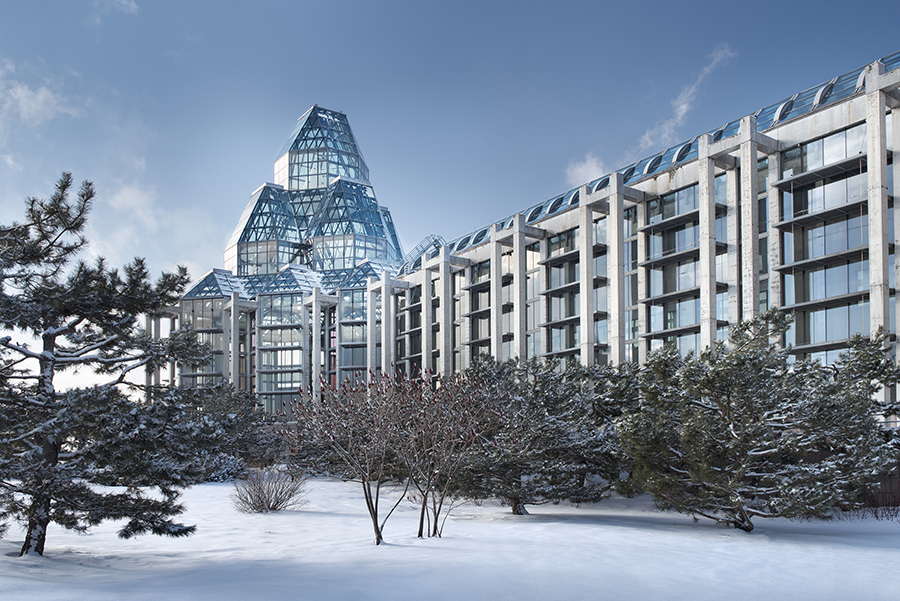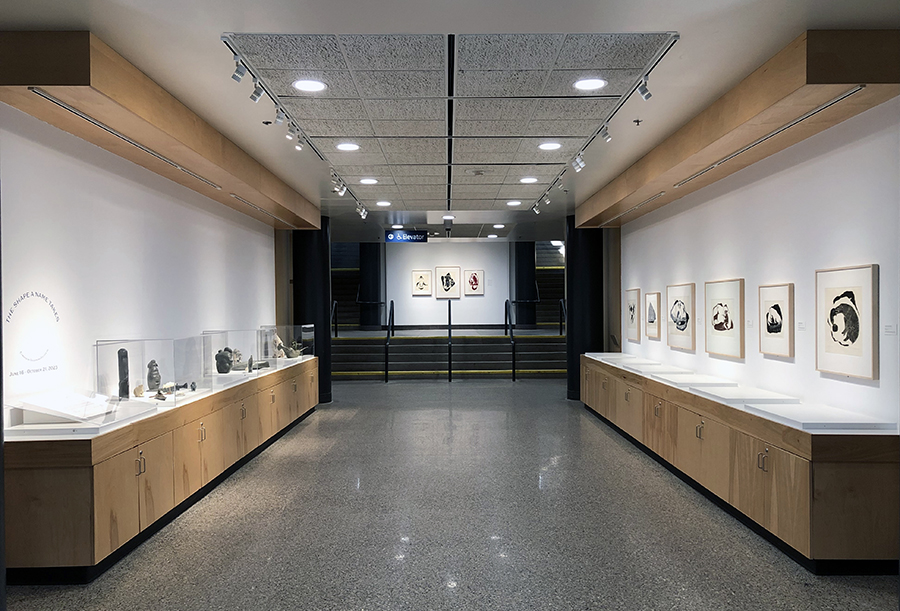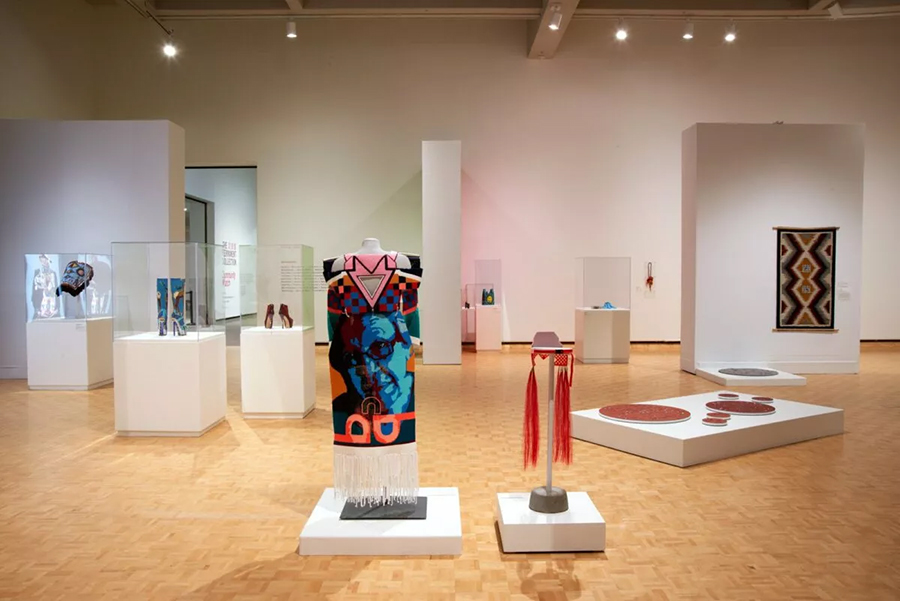The National Gallery of Canada (NGC) in Ottawa, ON, recently made history by having the most Inuit-staffed department of a gallery in Southern Canada following the hiring of its third Inuk staff member in October 2023. Since the establishment of the gallery’s Indigenous Ways and Decolonization (IWD) department in February 2022, the NGC has steadily hired Indigenous talent in curatorial and management positions to re-examine and re-imagine various aspects of the gallery in order to better engage with Indigenous Peoples. The IWD department’s Inuit staff members, Reneltta Arluk, Senior Manager, Policy, Protocols and Strategic Initiatives; [1] Jocelyn Piirainen, Associate Curator, Inuit Art; and Ooleepeeka Eegeesiak, Curatorial Assistant, Indigenous Art; spoke with the IAQ about this historic moment.
When asked how it feels to be part of the most Inuit-staffed gallery in the country, Arluk, who is an Inuvialuk, Dene and Cree artist and arts administrator from the Northwest Territories, said, “We should share this with people. I’m thrilled by it.”
Arluk is no stranger to leadership roles within arts institutions and organizations; prior to joining the IWD department in July 2023, she held the role of Director of Indigenous Arts at the Banff Centre for Arts and Creativity in Alberta and she has been the Artistic Director of Akpik Theatre since she founded it in 2008. “Ultimately when you do big work in institutions or work that is leadership, you really go into it as a form of service,” Arluk says. “I’m not elevating my work or my voice, I’m creating the space for us to be able to do this work together.” Arluk describes her role at the NGC as working with various departments as well as with senior management to determine how the gallery can bring in Indigenous ways of knowing and being. “A lot of it is value systems, input experience and protocol,” she says. “It really is embodying an Indigenous lens into all of these practices and all of these positions, and [ensuring] that when we’re engaging with our audience, that we’re doing it in a way that is inclusive.”
 The National Gallery of Canada in Ottawa, ON
COURTESY NGC
The National Gallery of Canada in Ottawa, ON
COURTESY NGC
Piirainen, who is an urban Inuk from Iqaluktuuttiaq (Cambridge Bay), NU, joined the IWD department in November 2022. She was formerly Assistant Curator of Inuit Art at the Winnipeg Art Gallery (WAG)-Qaumajuq and made history as not only the gallery’s first Inuk curator on staff but as the first Inuk in Canada to hold a permanent curatorial position at an art institution in the South. At the NGC, Piirainen and the other IWD Associate Curators oversee the NGC’s collection of First Nations, Métis and Inuit art: rotating parts of the NGC’s permanent collections on view every six to eight months, curating exhibitions and acquiring new works for the NGC—meaning Piirainen can shape the gallery’s Inuit art collection through an Inuit lens. “I wanted the opportunity to grow the gallery’s collection of Inuit art, bring in some of these voices to the gallery,” Piirainen says. “With the IWD we really get that opportunity to make changes from within the gallery itself.”
The newest member of the IWD department is Ooleepeeka Eegeesiak, who is an Inuk/Qallunaaq from Iqaluit, NU, and joined in October 2023. Formerly an Assistant Curator at the University of Lethbridge Art Gallery in Alberta, Eegeesiak is rapidly making moves in her career, having curated the 2023 exhibition The Shape a Name Takes at the University of Lethbridge Art Gallery and the 2024 exhibition -miut at the Mitchell Art Gallery in Edmonton, AB. As an Assistant Curator at the NGC, Eegeesiak supports the IWD Associate Curators with their research, acquisition processes and various tasks involved in curating exhibitions. “It’s been really special as someone who’s emerging in my career to be able to work with two really brilliant Inuit that I look up to and can learn from,” Eegeesiak says.
Piirainen shared with us some of her recent curatorial projects. She is working as the Co-ordinating Curator on the NGC iteration of Radical Stitch, the nationally touring landmark exhibition curated by Sherry Farrell Racette, Michelle LaVallee and Cathy Mattes. The exhibition, which celebrates contemporary Indigenous beading, held its inaugural show at the MacKenzie Art Gallery in Regina, SK, in 2022 and will travel to the NGC in May. In her role, Piirainen is working with the curators to bring more works by Inuit artists into the exhibition, such as works by Maata Kyak. Piirainen has also recently installed Shuvinai Ashoona’s, RCA, drawing Aquarium (2017) in one of the NGC’s contemporary galleries, marking this as the first time the work has been seen by the public since the NGC purchased it in 2019. Piirainen noted that the COVID-19 pandemic was one of the factors impeding its installation and is excited that the artwork is now visible.
 Installation view of The Shape a Name Takes, curated by Ooleepeeka Eegeesiak, 2023
ALL © THE ARTISTS COURTESY UNIVERSITY OF LETHBRIDGE ART GALLERY
Installation view of The Shape a Name Takes, curated by Ooleepeeka Eegeesiak, 2023
ALL © THE ARTISTS COURTESY UNIVERSITY OF LETHBRIDGE ART GALLERY
Hiring Inuit within three different organizational levels of a department is unprecedented for a public art gallery, and it provides opportunities for them to collaborate, mentor and build community with each other as well as with other Indigenous staff. Piirainen appreciates how supportive her colleagues are, describing the IWD department as, “a very tight-knit department [that is] filled with different perspectives, different life experiences. We all understand each other and understand our backgrounds as well.” Recognizing the significance of this event, Arluk shared that, “It’s important to tell these good news stories as well as the other stories we read about institutions.”
Three Inuit staff employed at the same time in a department at a major Canadian art institution, marks a significant moment for Inuit professionals working in the field. Historically, only a handful of Inuit have held senior or permanent roles in museums and galleries as employees, including Arluk when she was the Director at the Banff Centre for Arts and Creativity from 2017–2022, and Piirainen when she moved into the position of Associate Curator of Inuit Art at WAG-Qaumajuq, which she held from 2021–2022. Additionally, major Inuit art collections outside of the North have seldom been overseen by Inuit curators with the exception of Lisa Qiluqqi Koperqualuk, who was the Curator and Mediator of Inuit Art at the Montreal Museum of Fine Arts in Quebec from 2019–2022; Taqralik Partridge, who was the Curator of Indigenous Art – Inuit Art Focus at the Art Gallery of Ontario (AGO) in Toronto, ON, from 2022–2024; and Emily Laurent Henderson, who was Curatorial Assistant, Indigenous and Canadian Art at the AGO in 2023, and was appointed Associate Curator, Indigenous Art and Culture at the McMichael Canadian Art Collection in Kleinberg, ON, later that year. Since the curators’ departures from their respective institutions, each of their roles have remained vacant.
The departure of Partridge and Henderson from the AGO, which previously held the record for most Inuit staff, dropped the gallery’s number of Indigenous curatorial staff to zero. Partridge departed the gallery in January 2024 following the highly publicized exit of Wanda Nanibush, an Anishinaabe-kwe and the gallery’s inaugural Curator, Indigenous Art, in November 2023. Henderson left in the fall of 2023 to pursue a new opportunity at the McMichael Canadian Art Collection. Their departures have raised concerns from the public about the AGO’s governance policies and the future of the Department of Indigenous and Canadian Art, now without any Indigenous curators to oversee the collections, exhibitions and programming.
Meanwhile, Indigenous Ways and Decolonization is the NGC’s first Indigenous-led department; it is overseen by Steven Loft, Vice President; Michelle LaVallee, Director; and Arluk as Senior Manager. The department honours the NGC’s 2021–2026 Strategic Pillar that focuses on centring Indigenous ways of doing and knowledge. The department was established in 2022 following transformative shifts in the gallery’s operations under Sasha Suda’s tenure as Director and CEO. Later that year Greg Hill, former Audain Senior Curator of Indigenous Art at the NGC, was dismissed after 22 years of service, alongside three other senior staff, which led to media scrutiny of the gallery. Hill believes his questions about the new IWD department were the cause for his dismissal. In November 2023 comments made by current Director and CEO Jean-François Bélisle regarding decolonization in museums again drew public scrutiny to the gallery, and Bélisle has since apologized.
 Installation view of Radical Stitch at the MacKenzie Art Gallery, 2022, which will travel to the NGC in May 2024
PHOTO DON HALL COURTESY MACKENZIE ART GALLERY
Installation view of Radical Stitch at the MacKenzie Art Gallery, 2022, which will travel to the NGC in May 2024
PHOTO DON HALL COURTESY MACKENZIE ART GALLERY
When asked what decolonization meant to them within their arts practices, Piirainen, Arluk and Eegeesiak expressed that it is an inherent aspect of their work. For Piirainen, decolonization within her curatorial practice is about “creating a space, a very public-facing space, where Indigenous Peoples can feel safe, can feel seen; a space where they can basically relate themselves to it,” she says. This includes considering what artwork is being shown at the gallery and creating more opportunities for Indigenous Peoples—such as programs and events held by the NGC as well as internships, research and gallery positions.
Eegeesiak recognizes that “Decolonial ideas within art are intertwined with, and can actually change, our material realities as Indigenous Peoples.” She explains that artwork can be utilized within larger anti-colonial movements. “Art, as Inuit and more broadly as Indigenous people, is a vehicle through which we practice intergenerational skills, conceptualize our futures, relate to the land and our communities, and strengthen our languages. It also is a way to politicize and organize around our interests on an international scale through embedded ideas, building relationships, sharing resources and skills, advocating for our continued existence, and asserting our rights to land, water, and resources.”
For Arluk, decolonization as an artist starts with land. “Decolonial practice to me is staying connected to land,” she says. “What land are we on? Who are the people who have built this, who had these structures in place before we got here? What were their value systems and then, as we’re starting to build the story that we’re telling, who are the voices that we need to hear from? . . . Ultimately, everything to me is connected to place, and making sure that what we do in place is in reflection to what we’re doing as art.” Arluk practices this by centring the perspectives of the peoples whose land her work exists upon; this often includes reaching out to local community Elders and Knowledge Keepers for advice, such as the Algonquin Anishinaabeg whose territory the NGC exists on.
Though Arluk acknowledges that working in major institutions, even while implementing decolonial practices, can be challenging, she appreciates that she has others to do this work with. “There’s three Inuit,” she says. “[So we’re] not one voice speaking for everyone, which is really unique in a non-Indigenous institution and doesn’t exist anywhere else.”
NOTES
[1] Reneltta Arluk also serves as the Inuit Art Foundation Board Vice-President.